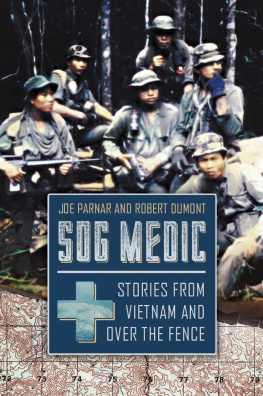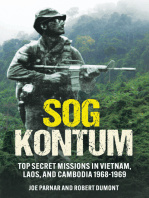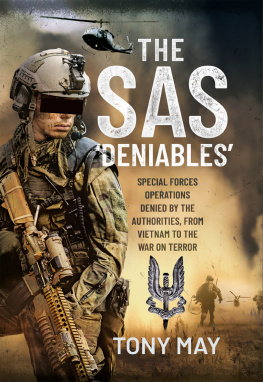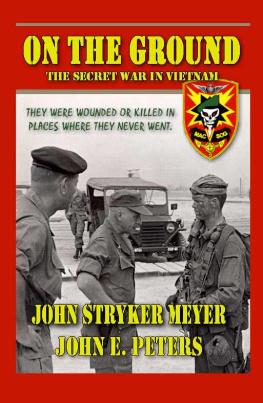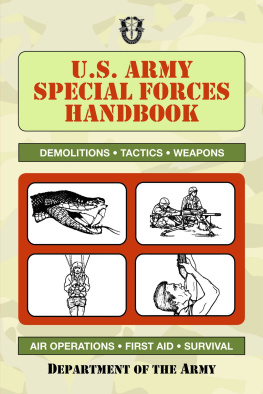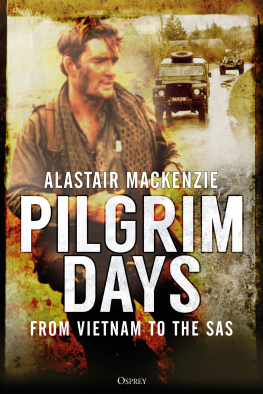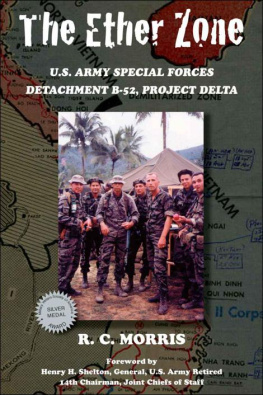Pagebreaks of the print version

SOG MEDIC
SOG MEDIC
Stories from Vietnam and Over the Fence
JOE PARNAR AND ROBERT DUMONT
Published in the United States of America and Great Britain in 2018 by
CASEMATE PUBLISHERS
1950 Lawrence Road, Havertown, PA 19083, USA
and
The Old Music Hall, 106108 Cowley Road, Oxford OX4 1JE, UK
Copyright 2018 Joe Parnar and Robert Dumont
First published by Paladin Press in 2007
Hardback Edition: ISBN 978-1-61200-633-8
Digital Edition: ISBN 978-1-61200-634-5 (ePub)
Kindle Edition: ISBN 978-1-61200-634-5 (Mobi)
A CIP record for this book is available from the British Library
All rights reserved. No part of this book may be reproduced or transmitted in any form or by any means, electronic or mechanical including photocopying, recording or by any information storage and retrieval system, without permission from the publisher in writing.
For a complete list of Casemate titles, please contact:
CASEMATE PUBLISHERS (US)
Telephone (610) 853-9131
Fax (610) 853-9146
Email:
www.casematepublishers.com
CASEMATE PUBLISHERS (UK)
Telephone (01865) 241249
Email:
www.casematepublishers.co.uk
This book is dedicated to all the brave warriors who fought with SOG and to the memory of: Craig Davis, July 6, 1946May 11, 2007, my brother in arms.
There was a consciousness always of the presence of his comrades about him. He felt the subtle battle brotherhood more potent even than the cause for which they were fighting. It was a mysterious fraternity born of the smoke and danger of death.
Stephen Crane, The Red Badge of Courage
Preface
The authors would like to thank Casemate for publishing this 2018 edition of SOG Medic. With additional text, maps, and photos, we hope it finds a wide audience of new readers and previous readers will wish to re-acquaint themselves with the book in a new format.
One of the most gratifying results since the books first publication in 2007 has been the number of people that have contacted us regarding various events chronicled in the original narrative. Weve been in touch with several individuals who were mentioned by name and communicated with them at greater length, thus enabling us to expand on various topics. Lee Swain, Paul Renner, William Groves, Tony Dorff, and Steve Roche are among these folks. In other instances, when the names were unknown to the authors at the time of the books first writing, we have since learned who several people were and what units they were assigned to. This is the case with Huey pilot Kent Harper and Cobra pilot Gary Higgins, both of whom played significant roles in the events depicted in .
There have also been instances when family members of persons killed in combat actions have come forward and expressed their gratitude for our relating the circumstances of those actions and memorializing their lost loved ones. Randy Ide and Alan Apperson are two examples, as well as the family of John Kedenburg.
We are especially pleased that the editors have chosen the image of Medal of Honor recipient John Kedenburg and his team for the cover . The events surrounding the loss of John Kedenburg are covered in somewhat greater detail in this edition as we have discovered further information. Hunts arresting photos and Joes vivid memories provide a fitting tribute to their fallen comrade.
Joe Parnar
Robert Dumont
Foreword
Over the years since the Vietnam War, a then-classified U.S. Army unit known as SOG (Studies and Observations Group) has spawned a large number of individual myths, legends, and war stories. Few match the varied perspectives and detailed recall of Special Forces medic Joe Parnar.
Joe served with SOG during 1968 and 1969 in the provincial capital city of Kontum near the tri-border area that gave the SOG commandos operating there access to the forbidden areas of Laos and Cambodia. During his tour with SOG, he served as dispensary medic, chase medic, Hatchet Force medic, and as a recon team member. This gives him an active voice and direct experience not only in an unusual number of combat roles but also in dealing with and treating the civilians and indigenous peoples of that area.
I first met Joe several years ago when doing research for my photo history book of SOG at CCC, Running Recon: A Photo History of SOG Special Ops along the Ho Chi Minh Trail (Paladin Press, 2004). He had left the SOG compound near Kontum called Command and Control Central about a month before I got there in April 1969. In looking for additional photographs for my own book, I was put in touch with Joe by a SOG memorabilia collector, and he generously allowed me the use of his photographs in my book. In speaking with Joe about our experiences in Vietnam, I was struck by the breadth of his experience and his ability to tell stories that provided real background and texture to his experiences, a vivid picture of what those experiences were like. He has an authentic voice, and he adds much to the life and corroboration of a unit that has, because of the secretive nature of its work, very little official documentation.
Thus, I am greatly pleased that Joe has taken the time to put down all his experiences in this book, for they are an important contribution to the history of SOG. At the same time, they sustain the myth of SOG exploits, the unique nature of its activities, and the extraordinary character of many of the men who served there. Joe speaks with a certain candor that may make some people uncomfortable; he doesnt clean it up to make it more acceptablehe tells it as he remembers it.
Joes stories also remind me of something that I didnt pay a lot of attention to at the time, namely the enormous responsibility and burden that a medic carries. He has to not only keep himself alive and functioning, but at the same time he has to take care of the wounded and suffering. When everyone else takes a break to rest or eat, he treats the wounded. When engaged in a firefight with the enemy, he doesnt stay down, he gets up and treats the wounded. When settling down at night, when others are resting or sleeping, he treats the wounded. And sometimes, after having returned to the FOB, he has the final duty, the privilege, of preparing the bodies of our dead for return to their families back home in the United States. These stories are not only a testimony to Joes efforts but also are part of the universal story of all medics who have served our troops, indeed all troops, throughout history. And to this day, Special Forces medics continue to carry out that tradition in all the corners of the world.
One of the problems of war stories is that they are often difficult to corroborate, or have some aspect that make them seem suspect, or at least exaggerated, and I wanted to be as truthful and accurate as I could be when doing my book. Joes recall is detailed and accurate, and it is also important to him that it be right. What I could check always corroborated with what he had to say, in fact, if not in perspective. In Joe and in this book, those two linchpins of relevant war stories, memory and perspective, are well met. This doesnt mean that everyone who was there will agree with him; it means that he has the right to tell his experiences.
Joe was patiently aided in these efforts to get his stories in print by the abilities of wordsmith Bob Dumont. It is a difficult job to get the words to flow smoothly while at the same time maintaining the authenticity of the speakers voice, and Bob has done that well. Simply put, good teamwork has produced this excellent book.

